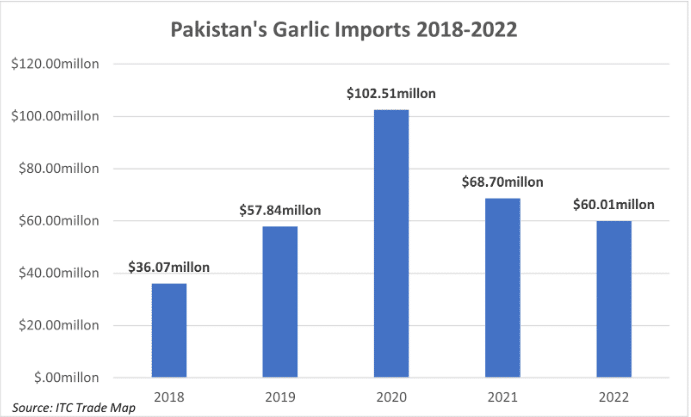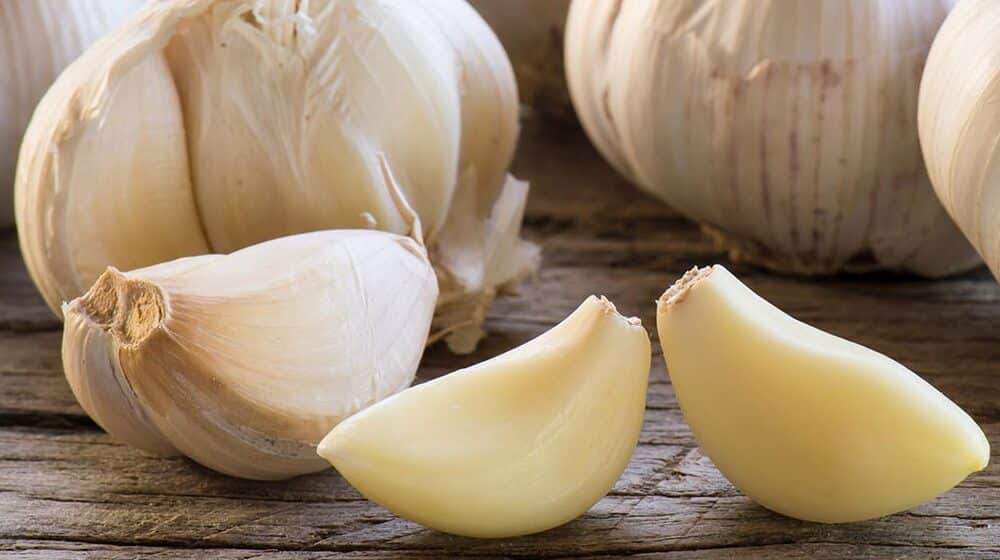On 9th October 2023, the Senate Standing Committee on Commerce after a detailed meeting directed the Pakistan Horticultural Development and Export Company (PHDEC) to a complete plan to identify, policy, investment and other support measures where assistance from the Export Development Fund (EDF) is required in order to support NARC G1 Garlic Growers.
The plan will be developed in consultation with all stakeholders including the Ministry of Commerce (MoC), the National Agriculture Research Centre (NARC), Provincial Governments and G1 Growers.
G1 Garlic is being auctioned in the vegetable markets in multiple cities at Rs. 200 per kg. Yes, you heard it right. It’s also reportedly available in Islamabad for Rs. 500 per kg. The same cultivar was being sold at Rs. 18,000 per kg a year ago and people were buying it in anticipation of 6-7x returns. It was a bubble and it burst, what now?
The good thing about such bubbles is that they burst but the bad thing is, you never know when they are going to. Before getting into the future of indigenous variety, how do we end up here?
How Lucrative Venture Turned Into Speculative Frenzy?
For those who never heard of it, G1 Garlic was one of the latest garlic cultivars introduced by the National Agriculture Research Centre (NARC) in 2019 and was hailed as the next-generation alternative to cut Pakistan’s reliance on garlic imports.
It reportedly provided a yield three times more than the conventional varieties and its big size coupled with the claimed fact that it remains viable for up to two years made it more lucrative for processing and value addition as well.
But it soon turned into a quick money-making tool for all investors big and small alike and what was introduced by the government at Rs. 500 per kg was being sold at one time for Rs. 18,000 per kg.
Strange right? But what was more strange was the fact that people were still buying it and that’s because a lot of people sold it as seed for 10x the amount they bought it so a lucrative venture turned into a speculative frenzy in no time. YouTube clickbait influencers brought the masses into the loop and big corporate investors also jumped in which gave it a whole different color altogether.
G1 Garlic was discovered as a part of a regular expedition of collecting & sorting germplasm by the Plant Genetic Research Institute nearly 15 years ago and was handed over to the horticulture department where its better traits against conventional cultivars were identified and more than a decade of R&D took place.
“It was still in the approval phase when a lot of people already had access to it, it had momentum and prices had already climbed from Rs. 2,000 to Rs. 3,000 per kg” revealed Dr Muhammad Azeem Khan, Ex-Chairman, Pakistan Agriculture Research Council while talking to ProPakistani
He added that then commercial investors started providing seeds with their buyback programme and that’s how it remained in a boom for 2-3 years. Though there are no accurate numbers available on its cultivation and we will come to why later, Dr Khan estimated that its acreage must be more than 40 to 50 thousand acres with a roughly similar number of growers.
Introducing a new variety after extensive R&D is a daunting task and having studied under some of the most renowned agricultural researchers in the country, I can attest to that but it’s just one aspect and when it comes to national level policy-making of a new crop, it’s whole another ball game and we haven’t been great at it.
Pakistan has been trying for decades to oilseed cultivation and cut $5 billion dollar edible oil import but success is nowhere to be seen yet for multiple reasons we will discuss sometime later. You study agriculture and you will get to know about such multiple high-value crops that were brought and introduced to scale decades earlier but still are in the very early stage of adoption but you rarely find exceptions like G1 Garlic which explodes out of proportion.
It’s entirely fair that policymakers did not see it coming because they are entirely used to the slow decades-long adoption cycles and they were simply not prepared to follow through with the unexpected boom in demand and supply.
“G1 Garlic seeds were distributed through three different channels. One was obviously officially through NARC which provided it to growers at Rs. 800 per kg and the second, nearly Rs. 1.3 million worth of seed was also stolen from NARC in September 2021 and huge batches of it were also allegedly provided to ‘retired urban growers’ through unofficial channels.” explained Nabeel Yusuf, Progressive Farmer and Founder Radical Growth Solutions while talking to ProPakistani.
He added that if the distribution had been managed effectively, slowly and in a traceable manner, the frenzy would not have happened and on top of that, the quality of the produce could also have been ensured easily.
All the agricultural commodities that have huge export potentials like corn, rice, and mangoes require strict quality checks before being marketed but if a businessman has the capacity to market something in the West but cannot be sure of the quality of the produce you’re going to buy locally, you may opt out of the pursuing that avenue.
The Question Remains
A number of commercial outlets have provided quality seeds to the growers and hopefully will be following up on the exports, processing and value addition of the priced cultivar as well but the question remains what of the people who were allegedly scammed into believing that the seed avenue for the G1 Garlic was here to stay forever. Small-scale farming in Pakistan mostly relies on loans and people borrowed money to enter this market and while some might have made huge sums in the start, people do stand to face huge losses.
Pakistan imported nearly $60 million worth of fresh and chilled garlic in 2022 according to the International Trade Center. While that may seem insignificant compared to Pakistan’s huge $8 billion worth of food import bill, the cultivar was still found worthy of attention by both the public and private sectors.

“G1 Garlic has never been grown as a crop but for the last four years, it has been grown from the perspective of seed. Last year too, everyone bought it for nearly Rs. 15000 per kg in order to multiply its seed and sell it accordingly but the market has saturated” stated Muhammad Ali Iqbal, CEO of Concave Agri while talking to ProPakistani.
He added that big investors have opted out of buying now so the prices have dropped but he still emphasized its potential due to yield and low perishability and affirmed that Concave Agri is still providing growers with seeds, doing partnerships with farms in Gilgit Baltistan and has also redesigned its geometry to reduce the seed rate by nearly 20 percent to cut the costs.
Growing G1 Garlic The Right Way
One more downside of the speculative frenzy was that since very few were aiming for sustainable value chain production and because it’s not a popular topic on YouTube and social media against ‘let’s be a millionaire’ talk, despite its huge production, its accurate production technology is still a question mark even for the acclaimed growers.
“We are also redesigning the geometry of plantations and are experimenting with reducing seed rate to 550-600kg per acre from 800kg per acre to cut the costs and increase the yield at the same time” added Iqbal.
Addressing the question regarding whether using G1 garlic results in a foam or scum formation in cuisine as said by some, Iqbal claimed that G1 Garlic’s one clove is sufficient to supplement the whole bulb of our conventional varieties so we have to use less of it to avoid foam formation so people might have to get used to it’s limited application.
Lastly, he stated that they are also in conversations with international players for exports and that is on their radar as well but businesses still working on it from the perspective of only seed may not be able to see it that way.
It’s a good thing that the bubble has burst and the tipping point is reached as ‘investors’ have got out of the game and the consumer market will develop again next year. Hopefully, now both the growers and researchers will attempt their best to figure out the right production technology for different use cases and consumer segments, though some things will always remain constant.
“Some farmers relied on heavy Urea application just to produce a bigger sized garlic which in addition to increasing the costs, also causes it to burst underground and badly affecting its quality and shelf life. Farmers have overestimated its size and consumers too are only going to like the normal size bulbs”, stated Ali Raza Kharal, G1 Grower from Ismail Ibrahim Farms while talking to ProPakistani.
He added that it’s important to use alternate sources of nitrogen for it instead of Urea, and it’s entirely possible to achieve higher profitability in G1 compared to conventional crops if only accurate plant population is ensured and proper protocols regarding storage conditions are followed to protect the quality which is prerequisite if we are looking to compete with Chinese garlic in market.
Talking about the past few years’ bubbles, Kharal agreed that most people who opted for it were ‘parachuters’ inspired by YouTube influencers who exaggerated its profits and were not interested in creating a value chain
What The Future Holds?
As stated at the start, the Ministry of Commerce is surprisingly proactive on this front and after a fruitful meeting with G1 Garlic Growers and Agro Division at MoC, the Government has formally sought a detailed plan for supporting the growers and exploring its export potential.
It’s true that the exponential growth in prices that brought in more people looking for short-term gains instead of those interested in building a sustainable value chain was not the only problem. The boom in prices and spread was both unexpected and there are a number of complaints of mixing and lower quality of the G1 garlic that has been produced during the last three years.
“While it’s true that it was outed in the market way before approval its traits are well known by everyone and its mixing with other produce is not that easy given its phenology and color. Now farmers have its pure lines and they will scale it up on their own” added Dr Khan.
He also added that quality certification service is available at the government level, the Ministry of Commerce is actively working on exploring its export potential, samples for value addition have already been sent to Europe and elsewhere, and new export markets like Africa are also being explored where it can’t be grown and with all that, further clarity will come in the market in next year.





















